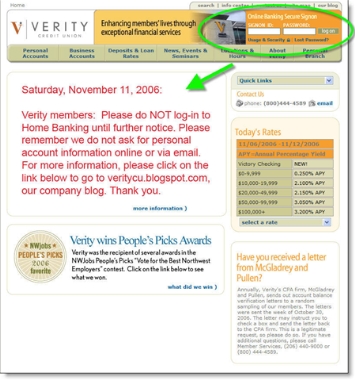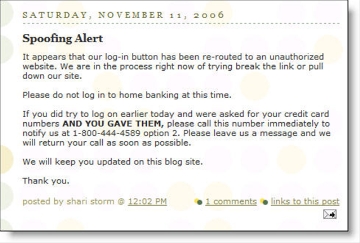 In banking, we haven’t had as much hype over a single day since Y2K. But with every major bank back-pedaling on debit card fees, the power of tomorrow’s Bank Transfer Day has diminished somewhat. Yet, it still should be a good week for smaller players to grab market share.
In banking, we haven’t had as much hype over a single day since Y2K. But with every major bank back-pedaling on debit card fees, the power of tomorrow’s Bank Transfer Day has diminished somewhat. Yet, it still should be a good week for smaller players to grab market share.
The Deposit Accounts blog had a run down of some special offers in effect tomorrow, including the “gloves off” homepage promo from Seattle’s Verity Credit Union (click inset to enlarge; note 1).
And here are a few more switch pages. Last week, I highlighted Freestar Bank’s effort. Here are four more (screenshots/links below):
- Community 1st CU
- 1st Advantage CU
- First Bank and Trust
- Bank of Tennessee, which has the most interesting landing page by a long-shot (see last three screenshots)
All but the first are are powered by Deluxe’s SwitchAgent (note 2).
——————————
Community 1st Credit Union homepage (link; 31 Oct 2011)
1st Advantage FCU homepage (link)
First Bank and Trust homepage (link)
Note: You cannot click through this ad. The call to action is “visit your banker”
Bank of Tennessee homepage (link)
Bank of Tennessee landing page, part 1 (link)
Landing page part 2
Landing page part 3
————————————-
Notes:
1. While you are at Verity click over to its Verity Mom social media effort (powered by Currency Marketing) and see the amazing turnout they had for their second annual spokester contest, 69 one-minute videos were submitted.
2. The reason why I’m showing so many Deluxe examples is because I used “SwitchAgent” in my search and found interesting examples. They have 14 clients using the new service, which we first heard about at BAI Retail Delivery a few weeks ago.
3. We write about these issues and much more in our subscription service, Online Banking Report.
































